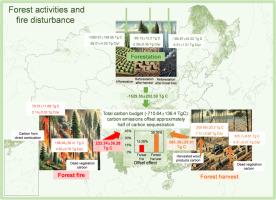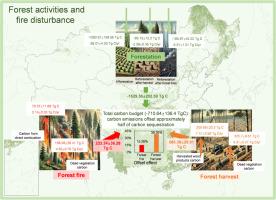1986-2020年,中国森林采伐和火灾产生的碳排放抵消了大约一半的造林固碳
IF 5.7
1区 农林科学
Q1 AGRONOMY
引用次数: 0
摘要
森林活动和火灾干扰(FAFD)在全球碳循环中起着重要作用。尽管已经有许多研究探讨了造林、森林采伐和森林火灾对中国碳循环的个别影响,但它们的综合影响尚不清楚。此外,很少有研究在物种水平上考察这些活动对净碳收支的影响。通过将遥感、详细树种和统计数据整合到空间化建模方法中,估算了1986-2020年中国三种主要FAFD(即造林、森林采伐和森林火灾)的碳收支。研究发现,FAFD总体上净固碳量为-710.64±136.4 Tg C,其中造林固碳量为-1529.36±202.59 Tg C,森林采伐碳排放为585.38±29.91 Tg C,火灾碳排放为233.34±36.28 Tg C。在空间上,全国平均固碳密度为-172.95 Mg C km-2,区域差异显著。森林采伐和火灾的碳排放抵消了造林固碳的53.52%(分别为38.26%和15.26%)。超过90%的树种表现出造林和采伐的净碳固存。森林采伐对全国的抵消影响因树种而异,在3.51% ~ 101.27%之间。由于森林采伐的高碳排放,栎树和桉树表现出97%以上的抵消效应。油松和落叶松由于固碳量大,抵消效应较小,分别为3.51%和10.23%。这些发现强调了考虑森林砍伐和森林火灾造成的碳排放在通过造林实现碳固存最大化方面的重要性。本文章由计算机程序翻译,如有差异,请以英文原文为准。


Carbon emissions from forest harvest and fire offset approximately half of carbon sequestration of forestation in China during 1986-2020
Forest activities and fire disturbance (FAFD) play an important role in the global carbon cycle. Although many studies have been explored to examine the individual effect of forestation, forest harvest, and forest fire on the carbon cycle in China, their combined impacts remain unclear. Moreover, rare research has been examined the impacts of these activities at the species level on the net carbon budget. By integrating remotely sensed, detailed tree species and statistical data into a spatialized modeling approach, we estimated the carbon budget from three major FAFD (i.e., forestation, forest harvest and forest fire) in China during 1986-2020. We found that FAFD overall showed net carbon sequestration of total -710.64±136.4 Tg C with sequestration of -1529.36 ± 202.59 Tg C from forestation and emission of 585.38 ± 29.91 Tg C from forest harvest and 233.34 ± 36.28 Tg C from fire. Spatially, the national average carbon sequestration density from FAFD was -172.95 Mg C km-2, with notable regional variations. Carbon emissions from forest harvest and fire offset 53.52% (38.26% and 15.26%, respectively) of carbon sequestration from forestation. More than 90% of tree species exhibited net carbon sequestration from forestation and harvest. The national offset impact of forest harvest varied by tree species, ranging from 3.51% to 101.27%. Owing to high carbon emission from forest harvest, Quercus and Eucalyptus showed large offset effects over 97%. In contrast, Pinus tabulaeformis and Larix demonstrated small offset effects of only 3.51% and 10.23% due to high carbon sequestration. These findings highlight the importance of accounting for carbon emissions from deforestation and forest fire when aiming to maximize carbon sequestration through forestation.
求助全文
通过发布文献求助,成功后即可免费获取论文全文。
去求助
来源期刊
CiteScore
10.30
自引率
9.70%
发文量
415
审稿时长
69 days
期刊介绍:
Agricultural and Forest Meteorology is an international journal for the publication of original articles and reviews on the inter-relationship between meteorology, agriculture, forestry, and natural ecosystems. Emphasis is on basic and applied scientific research relevant to practical problems in the field of plant and soil sciences, ecology and biogeochemistry as affected by weather as well as climate variability and change. Theoretical models should be tested against experimental data. Articles must appeal to an international audience. Special issues devoted to single topics are also published.
Typical topics include canopy micrometeorology (e.g. canopy radiation transfer, turbulence near the ground, evapotranspiration, energy balance, fluxes of trace gases), micrometeorological instrumentation (e.g., sensors for trace gases, flux measurement instruments, radiation measurement techniques), aerobiology (e.g. the dispersion of pollen, spores, insects and pesticides), biometeorology (e.g. the effect of weather and climate on plant distribution, crop yield, water-use efficiency, and plant phenology), forest-fire/weather interactions, and feedbacks from vegetation to weather and the climate system.

 求助内容:
求助内容: 应助结果提醒方式:
应助结果提醒方式:


